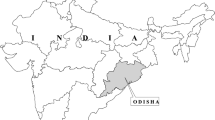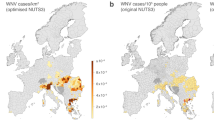Abstract
Arboviral diseases are a theme of high interest in the field of public and collective health worldwide. Dengue, Zika, and Chikungunya, in particular, have shown significant expansion in terms of morbidity and mortality in different portions of the ecumene. These diseases are of great interest in geographic studies due to the characteristics of their vector (Aedes aegypti), adapted to the environmental and unequal context of the urbanization process. Given this background, this study assesses the relationship between global climate change and the risk of arboviral diseases for the state of Rio de Janeiro. To this end, the characteristics of future climate susceptibility to vector proliferation in the scenarios RCP 4.5 and 8.5 (2011-2040 and 2041-2070) were assessed using two models: Eta HadGEM2-ES and Eta MIROC5, as well as the vulnerability conditions that favor the spread of arboviruses. The results indicate that the tendency of thermal and hygrometric elevation, in association with vulnerability, may have repercussions on the intensification and spatial expansion of the risk of arboviral diseases in the state of Rio de Janeiro, since there is a spatial and temporal expansion of the optimal environmental conditions for the development of the vector.








Similar content being viewed by others
Data availability
Arbovirus data available at DATASUS (http://www2.datasus.gov.br/DATASUS/index.php), database sustained by Ministry of Health of Brazil and climate modeling data available by National Institute for Space Research (INPE). All data used are in public domain.
References
Aleixo NCR, Sant’Anna Neto JL (2011) Percepção e riscos: abordagem socioambiental do processo saúde-doença. Mercator 22:191–208
Barata RB (2009). Como e por que as desigualdades sociais fazem mal à saúde. Rio de Janeiro: editora Fiocruz.
Bernardes LMC (1953) Tipos de clima do estado do Rio de Janeiro. Revista Brasileira de Geografia, n.1, Rio de Janeiro: IBGE/Conselho Nacional de Geografia.
Black T (1994) The new NMC mesoscale Eta Model: Description and forecast examples. Weather Forecast 9:265–278
Câmara FP, Theophilo RL, Santos GT, Pereira SR, Câmara DC, Matos RR (2007) Estudo retrospectivo (histórico) da dengue no Brasil: características regionais e dinâmicas. Rev Soc Bras Med Trop 40(2):192–196
Cassab A, Morales V, Mattar S (2011) Factores climáticos y casos de Dengue em Montería, Colombia. 2003-2008. Revista de Salud Pública 13:115–128
Chou SC, Lyra A, Mourão C, Dereczynski C, Pilotto I, Gomes J, Sueiro G, Siqueira G, Marengo J (2014a) Assessment of Climate Change over South America under RCP 4.5 and 8.5 Downscaling Scenarios. Am J Clim Chang 3:512–527. https://doi.org/10.4236/ajcc.2014.35043
Chou SC, Lyra A, Mourão C, Dereczynski C, Pilotto I, Gomes J, Bustamante J, Tavares P, Silva A, Rodrigues D, Campos D, Chagas D, Sueiro G, Siqueira G, Nobre P, Marengo J (2014b) Evaluation of the Eta simulations nested in three global climate models. Am J Clim Chang 3:438–454
Chou SC, Silva A, Lyra A, Mourão C, Dereczynski C, Rodrigues D, Campo D (2016) Simulação em alta resolução das mudanças climáticas sobre a América do Sul. Brasil - Ministério da Ciência, Tecnologia e Inovação (org.) Modelagem Climática e Vulnerabilidades Setoriais à Mudança do Clima no Brasil. Brasília: Ministério da Ciência, Tecnologia e Inovação, 49-91.
Collischonn E, Dubreuil V, e Mendonça F (2018) Relações entre o clima e saúde: o caso da dengue no Rio Grande do Sul no período de 2007 a 2017, Confins. https://doi.org/10.4000/confins.15431.
Confalonieri UE, Marinho DP (2007) Mudança climática global e saúde: Perspectivas para o Brasil. Revista Multiciencia, Campinas, Maio, pp 48–64
Consoli R, Oliveira RL (1994) Principais mosquitos de importância sanitária no Brasil. FIOCRUZ, Rio de Janeiro, 228p
Donalisio MR, Freitas ARR, Zuben APB (2017) Arboviroses emergentes no Brasil: desafios para a clínica e implicações para a saúde pública. Rev Saúde Pública 31:10–15
Farnesi LC, Martins AJ, Valle D, Resende GL (2009) Embryonic develompment of Aedes aegypti (Diptera: Culicidae): influence of different constant temperatures. Mem Inst Oswaldo Cruz 104:124–126
Flato GM (2011) Earth system models: an overview. WIREs Clim Change 2:783–800. https://doi.org/10.1002/wcc.148
Foo L, Lee HL, Fang R (1985) Rainfall, abundance of Aedes aegypti infection in Selangor, Malaysia. Southeast Asian J Trop Med Public Health 16:560–568
Fullerton L, Dickin S, Waa C (2014). Mapping Global Vulnerability to Dengue using the Water Associated Disease Index. ONU: United Nations University.42p.
Gomes AC, Forattini OP, Kakitani I, Marques GR, Marques CC, Marucci D et al (1992) Microhabitats de Aedes albopictus (Skuse) na região do Vale do Paraíba, Estado de São Paulo, Brasil. Rev Saude Publica 26(2):108–118
Gordon C, Cooper C, Senior CA, Banks H, Johns TC, Mitchell JFB, Wood RA (2000) Simulation of SST, Sea Ice Extents and Ocean Heat Transport in a Version of the Hadley Centre Coupled Model without Flux Adjustments. Clim Dyn 16:147–168
Gould E, Pettersson J, Higgs S, Charrel R, De Lamballerie X (2017) Emerging arboviruses: why today? One Heal 4:1–13
Gregianini TS, Ranieri T, Favreto C, Nunes ZMA, Tumioto Giannini GL, Sanberg ND et al (2017) Emerging arboviruses in Rio Grande do Sul, Brazil: Chikungunya and Zika outbreaks, 2014-2016. Rev Med Virol 17:1–10
Harvey D (1989) Condição Pós-Moderna. Edições Loyola, São Paulo
Harvey D (2004) Espaços de Esperança. Edições Loyola, São Paulo
Hayden M, Uejio C, Walker K, Ramberg F, Moreno R, Rosales C, Gameros M, Mearns L, Zielinski-Gutierrez E, Janes C (2010) Microclimate and human factors in the divergent ecology of Aedes aegypti along the Arizona, US / Sonora, MX Border. Ecosyst Health 25:1–14. https://doi.org/10.1007/s10393-010-0288-z
IBGE – Instituto Brasileiro de Geografia e Estatística (2010). Sinopse do Censo Demográfico 2010. Disponível em: www.ibge.gov.br Acesso em: 20/10/2019.
Intergovernamental Panel On Climate Change - IPCC (2014) Climate Change 2014 - Synthesis Report. A Contribution of Working Groups I, II, and III to the Fifth Assessment Report (AR5) of the Integovernmental Panel on Climate Change [Watson, R.T. and the Core Writing Team (Eds.)]. Cambridge, UK e New York, NY, USA: Cambridge University Press: 398 pp. JOHANSSON, 2009.
Johansson MA, Cummings DAT, Glass GE (2009) Multiyear Climate Variability and Dengue—El Niño Southern Oscillation, Weather, and Dengue Incidence in Puerto Rico, Mexico, and Thailand: A Longitudinal Data Analysis. PLoS Med 6 (11):e1000168. https://doi.org/10.1371/journal.pmed.1000168
Julião PR, Nery F, Ribeiro JL, Branco MC, Zêzere JL (2009) Guia metodológico para a produção de cartografia Municipal de risco e para a criação de sistemas de informação geográfica (SIG) de base municipal. Governo Federal, Portugal
Kousky VE (1988) Pentad outgoing longwave radiation climatology for the South American sector. Rev Bras Met 3:217–231
Lambrechts L et al (2011) Impact of daily temperature fluctuations on dengue virus transmission by Aedes aegypti. Proc Natl Acad Sci 108:7460–7465
Lyra A, Tavares P, Chou SC, Sueiro G, Dereczynski C, Sondermann M, Silva A, Marengo J, Giarolla A (2017) Climate change projections over three metropolitan regions in Southeast Brazil using the non-hydrostatic Eta regional climate model at 5-km resolution. Theor Appl Climatol 132 (1-2):663–682
Marafon GJ, Ribeiro MA, Corrêa RS, Vasconcelos VN (2011) Geografia do Estado do Rio de Janeiro: Da compreensão do passado aos desafios do presente. Editora Gramma, Rio de Janeiro
Mendonça FA, Roseghini WFF, Ceccato P (2019) Urban Climate and Dengue Epidemics in Brazil. In: Cristián Henríquez; Hugo Homero (Orgs.). Urban Climates in Latin America. 1ed. Cham: Springer Nature, 1:309-328.
Mendonça F (2003) Aquecimento global e saúde: uma perspectiva geográfica – notas introdutórias. Revista Terra Livre, AGB / São Paulo, jan/jul 2003 – 205-221 pgs.
Mendonça F (2015) Resiliência Urbana: Concepções e desafios em face de mudanças climáticas globais. In: FURTADO, F.; PRIORI JUNIOR, L., ALCANTARA, E. (Orgs). Mudanças climáticas e resiliência de cidades. Recife: Pikimagem, (pgs. 45-60).
Mendonça FA, Roseghini WFF, Aquino Jr (2011) Climate change, weather types and dengue: a comparative approach between Giruá (RS) and Maringá (PR) Brasil. UGI - 2011: Conferencia Geografia Regional, 2011, Santiago. Chile. UGI 2011 – Conference Proceedingins. Santiago. Chile: UGI / FISA, 1:1–12
Mesinger F, Chou SC, Gomes JL, Jovic D, Bastos P, Bustamante J, Lazic L, Lyra A, Morelli S, Ristic I, Veljovic K (2012) An upgraded version of the Eta Model. Meteorog Atmos Phys 116:63–79
Nimer E (1979) Climatologia do Brasil. IBGE, Rio de Janeiro
Nunes LH (2009) Compreensões e ações frente aos padrões espaciais e temporais de riscos e desastres. Revista Territorium 16:179–189
Oliveira, R. F. (2019). O papel do clima na ocorrência da Chikungunya, Dengue e Zika entre 2007 e 2017 nos bairros de Copacabana, Guaratiba, Jardim Botânico e Santa Cruz da cidade do Rio de Janeiro. Dissertação (Mestrado) – Programa de Pós-graduação em Geografia, Faculdade de Formação de Professores, Universidade do Estado do Rio de Janeiro.
Patz J, Campbell-Lendrum D, Holloway T, Foley, J. (2005) Impact of regional climate change on human health, Nature
Pereira CAR, Barata MML, Hoelz MPC, Medeirs VNLO, Marincola FV, Neto CC, Marinho DP, Oliveira TVS, Trigo AGM, Mederios TK (2014) Avaliação econômica dos casos de Dengue atribuídos aos desastres de 2011 em Nova Friburgo (RJ), Brasil. Ciência e Saúde Coletiva 19(9):3693–3704. https://doi.org/10.1590/1413-81232014199.01682014
Reis IC, Honório NA, Codeço CT, Magalhães MA, Lourenço-de-Oliveira R, Barcellos C (2010) Relevance of differentiating between residential and non-residential premises for surveillance and control of Aedes aegypti in Rio de Janeiro. Brazil Acta Trop 114(1):37–43
Reiter P (2004) Global warming and malaria: A call for accuracy. The Lancet – Infectious Diseases. Vol. 4, June 2004, pp. 323-324. (Reflection & Reaction). http: //infection.thelancet.com.
Rio de Janeiro – Secretaria Estadual de Saúde (2019) Informe epidemiológico 02/2019. Rio de Janeiro: Superintendência de Gestão em Vigilância da Saúde, 8p. Disponível em: < http://www.10minutossalvamvidas.rj.gov.br/Publico/MostrarArquivo.aspx?C=%2bG4XBzxqCN4%3d> Acesso em 22 abr 2020.
Rouquayrol MZ (1993) Epidemiologia e saúde. MEDSI, Rio de Janeiro
Santos M (1993) A urbanização brasileira. HUCITEC, São Paulo
Santos M (2008) A Natureza do Espaço: Técnica e Tempo, Razão e Emoção. Editora da Universidade de São Paulo, São Paulo
Silva WL, Dereczynski CP (2014) Caracterização Climatológica e Tendências Observadas em Extremos Climáticos no Estado do Rio de Janeiro. Anuário do Instituto de Geociências – UFRJ 37:123–138
Smith N (1988) Desenvolvimento Desigual. Bertrand, Rio de Janeiro
Sousa TCM, Amancio F, Hacon SS, Barcellos C (2018) Doenças sensíveis ao clima no Brasil e no mundo: revisão sistemática. Rev Panam Salud Publica 42:85. https://doi.org/10.26633/RPSP.2018.85
Torres, R. R. (2014) Análise de incertezas em projeções de mudanças climáticas na América do Sul. Tese (Doutorado em Meteorologia). São José dos Campo: Instituto Nacional de Pesquisas Espaciais – INPE. 239p.
UN – World Health Organization (2019). UN-Water global analysis and assessment of sanitation and drinking-water (GLAAS) 2019 report. UN: WHO, 144p. Disponível em: < https://www.who.int/water_sanitation_health/publications/glaas-report-2019/en/> acesso em 10 fev 2020.
Viana DV, Ignotti E (2013) A ocorrência da dengue e variações meteorológicas no Brasil: revisão sistemática. Revista brasileira de epidemiologia 16:240–256
Vianello RL, Pessanha JEM, Sediyama GC (2006) Previsão de ocorrência dos mosquitos da dengue em Belo Horizonte, com base em dados meteorológicos. Proceedings of the 14th Congresso Brasileiro de Meteorologia 1:1–20
Vuuren DP, Edmonds J, Kainuma M et al (2011) The representative concentration pathways: an overview. Clim Chang 109:5–31. https://doi.org/10.1007/s10584-011-0148-z
Acknowledgements
This study was financially supported by the National Council for Scientific and Technological Development (CNPq) and the Research Support Foundation of the State of Rio de Janeiro (FAPERJ). The authors would also like to thank the Institute for Space Research (INPE) for making climate model data available.
The authors would like to thank the Academic Publishing Advisory Center (Centro de Assessoria de Publicação Acadêmica, CAPA – < www.capa.ufpr.br >) of the Federal University of Paraná (UFPR) for assistance with English language translation and editing.
Code availability
No applicable
Funding
FAPERJ (Grant number: 26010001911/2019) and CNPq (Grant number: 40848320180)
Author information
Authors and Affiliations
Contributions
A. C. Oscar Júniorwas responsible for data analysis and mapping and F. Mendonça was responsible for writing and searching for bibliography.
Corresponding author
Ethics declarations
Ethics approval
No applicable
Consent to participate
No applicable
Consent for publication
No applicable
Competing interests
The authors declare no competing interests.
Additional information
Publisher’s note
Springer Nature remains neutral with regard to jurisdictional claims in published maps and institutional affiliations.
Rights and permissions
About this article
Cite this article
Oscar Júnior, A.C., de Assis Mendonça, F. Climate change and risk of arboviral diseases in the state of Rio de Janeiro (Brazil). Theor Appl Climatol 145, 731–745 (2021). https://doi.org/10.1007/s00704-021-03663-4
Received:
Accepted:
Published:
Issue Date:
DOI: https://doi.org/10.1007/s00704-021-03663-4




